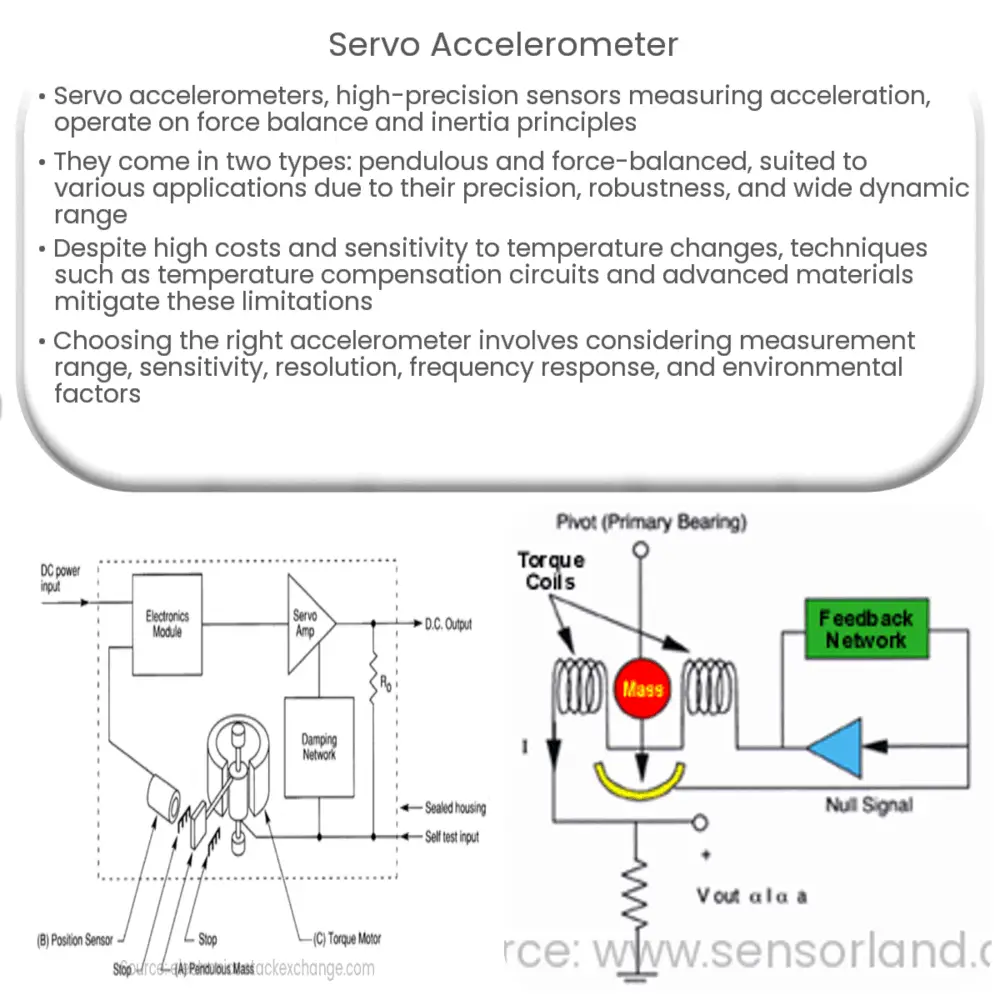A servo accelerometer is a high-precision sensor that measures acceleration using force balance principles, widely used in aerospace, military, and industrial applications.

Servo Accelerometer: A Comprehensive Introduction
Understanding the Basics of Servo Accelerometers
A servo accelerometer is a type of sensor that measures acceleration, specifically, the rate of change of velocity with respect to time. This high-precision device plays a crucial role in various applications, ranging from aerospace to industrial automation. In this article, we will delve into the fundamentals of servo accelerometers, their underlying technology, and some of their key uses.
Working Principle of Servo Accelerometers
Servo accelerometers operate based on the principles of inertia and force balance. Inside the sensor, a mass is suspended by a spring or a flexure. When the accelerometer experiences acceleration, the inertial force exerted by the mass causes it to move. This displacement generates a restoring force proportional to the acceleration, which is then measured by the accelerometer’s sensing elements.
A feedback loop maintains the force balance within the system. The displacement of the mass is detected by a position sensor, such as a capacitive, inductive, or optical sensor. The output signal from the position sensor is amplified and sent to a torque generator, which generates a counteracting force to restore the mass to its equilibrium position. The output of the torque generator is directly proportional to the acceleration experienced by the sensor, allowing it to provide highly accurate measurements.
Types of Servo Accelerometers
There are two main types of servo accelerometers: the pendulous servo accelerometer and the force-balanced servo accelerometer.
Pendulous Servo Accelerometer
In a pendulous servo accelerometer, a pendulum serves as the inertial mass. The pendulum is mounted on a pivot and is free to swing in response to acceleration. A position sensor detects the pendulum’s angular displacement, while a torque generator creates a counteracting force to restore the pendulum to its equilibrium position. The output signal of the torque generator is proportional to the acceleration experienced by the accelerometer.
Force-Balanced Servo Accelerometer
Force-balanced servo accelerometers utilize a suspended mass that is free to move in a linear fashion along a single axis. A position sensor detects the linear displacement of the mass, and a torque generator provides the counteracting force necessary to maintain the mass in its equilibrium position. Like the pendulous servo accelerometer, the output signal of the torque generator in a force-balanced servo accelerometer is proportional to the acceleration experienced by the device.
Advantages and Applications of Servo Accelerometers
Servo accelerometers offer several advantages over other types of accelerometers. Their high precision and wide dynamic range make them ideal for use in demanding applications, such as aerospace, military, and industrial automation. These sensors can measure both static and dynamic accelerations, which is crucial for various applications like inertial navigation systems, guidance systems, and vibration monitoring. Additionally, servo accelerometers are known for their robustness, durability, and ability to withstand harsh environments.
Limitations of Servo Accelerometers
Despite their numerous advantages, servo accelerometers also have some limitations. One notable drawback is their relatively high cost, which may be prohibitive for certain applications. Additionally, these sensors can be sensitive to temperature changes, which can cause measurement errors if not properly accounted for. Lastly, servo accelerometers may have a limited frequency response, as the feedback loop can introduce phase lag, making them less suitable for applications requiring high-frequency measurements.
Addressing the Limitations
Manufacturers have developed techniques to mitigate the limitations of servo accelerometers. For instance, temperature compensation circuits can be used to minimize the effects of temperature changes on the sensor’s output. Advanced materials, such as quartz or silicon, can be employed to reduce the sensitivity of the sensor to temperature variations. Moreover, advanced signal processing techniques can help improve the frequency response of the accelerometer and reduce phase lag in the feedback loop.
Selecting the Right Servo Accelerometer
When choosing a servo accelerometer for a specific application, several factors need to be considered. Some of the key parameters to take into account include:
- Measurement range: The maximum acceleration the sensor can measure without saturation or loss of accuracy.
- Sensitivity: The ratio of the sensor’s output signal to the input acceleration.
- Resolution: The smallest detectable change in acceleration that the sensor can measure.
- Frequency response: The range of frequencies over which the accelerometer can accurately measure acceleration.
- Environmental factors: The operating temperature range, humidity, and other environmental conditions that the sensor can withstand.
By carefully considering these factors and consulting with accelerometer manufacturers, you can select the most suitable servo accelerometer for your application.
Conclusion
Servo accelerometers are high-precision sensors that play a critical role in a wide array of applications, including aerospace, military, and industrial automation. Their ability to measure both static and dynamic accelerations, along with their robustness and durability, make them an attractive choice for many industries. While they do have some limitations, such as sensitivity to temperature changes and a limited frequency response, these drawbacks can often be addressed through careful selection and the implementation of advanced techniques. Understanding the principles, types, advantages, and limitations of servo accelerometers can help you choose the right sensor for your specific needs.

